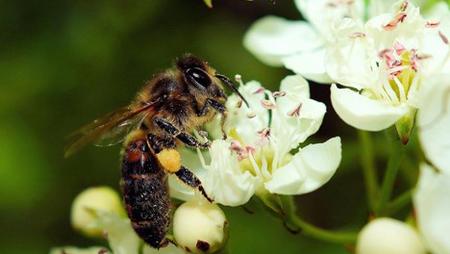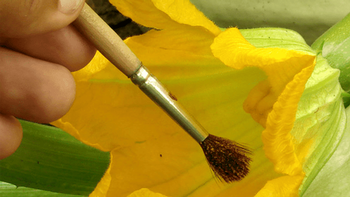News from the Edible Demo Garden
June 2022: Welcome Pollinators!

What’s so complicated about pollination?
Pollination occurs when pollen from a stamen or male part of a flower is transferred to the pistil or female flower part. Germination begins when the pollen reaches the ovary of the flower and fruit development follows. Most flowers, however, need help getting the pollen onto the pistil and that’s where the pollinators come in. While we commonly think of bees and other insects as pollinators, pollen is also transferred by wind, water, birds, bats, and small mammals. Pollination is the unintended consequence when a bee or butterfly moves from flower to flower to gather pollen or sip nectar and drops off extra grains of pollen in the process.
Types of pollination
While there are many types of pollinators, there are only two types of pollination – self-pollination and cross-pollination.
- Self-Pollination A flower is considered self-pollinating if the whole process can occur within the same flower. Transfer of pollen from stamen to pistil only requires some air movement. Lettuce, peas, beans, tomatoes, eggplant, and peppers are self-pollinating.
- Cross-Pollination Cross-pollination requires the transfer of pollen from the stamen of one flower to the pistil in another flower. In some edibles, the flowers need to be on different plants. Spinach, beets, carrots, corn, onions, cabbage, and squash are cross-pollinating.
Pollination in fruit trees
Most fruit trees are cross-pollinating, and many require pollination between two or more trees, sometimes of a different variety. A lone apple tree, for example, may produce little or no fruit if there is no other apple variety close enough to provide bee or wind carried pollen.
Pollination in cucurbits
Plants in the Cucurbitaceae family, which includes cucumbers, squash, and melons, produce separate male and female flowers. Typically, the male flowers appear first followed in a week or so by the female flowers. The female flowers can be recognized by the swelling at the base of the flower that looks like a miniature fruit. Bees do the major work of transferring the pollen from the male to the female flower.
Pollination Problems
Pollination depends on the right environmental conditions for both plants and pollinators. Too much rain and cold, lack of sun, extreme heat, drought, and the presence of pesticides can all reduce the formation of healthy flowers and discourage pollinators. Pollination may not occur, or it may be incomplete, affecting the quality, amount, and appearance of the fruit. In cucurbits, the timing for the female flowers may be off and there may not be enough male flowers remaining to pollinate them.
 Hand pollination can assist the work of bees. Photo: planetnatural.com
Hand-pollination
Hand pollination can assist the work of bees. Photo: planetnatural.com
Hand-pollination

When natural pollination is deficient, dedicated gardeners can become pollinators. Even in the Edible Demo Garden where there are plenty of flowers to attract bees and the plants are well cared for, the pollinators can sometimes use some human help. When flowers appear and no fruit begins to develop, it could be time to employ one of the following hand-pollinating methods.
- Shaking – In self-pollinating plants, simply shaking the plant may be enough to move the pollen grains within the flowers
- Brushing – A soft artist paintbrush can be used to transfer pollen within or among flowers, mimicking the action of bees.
- Swabbing – Similar to a paintbrush, a cotton swab can also be used to cross-pollinate.
- Using a battery-powered toothbrush – Crazy as it sounds, an electric toothbrush can provide both vibration and direct pollen transfer.
More information on growing edibles is available on this website at http://marinmg.ucanr.edu/EDIBLES/.
